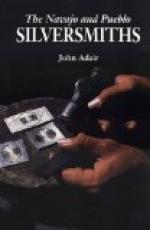The processes of the Navajo silversmith may be best understood from descriptions of the ways in which he makes some of his silver ornament. I once engaged two of the best workmen in the tribe to come to Fort Wingate and work under my observation for a week. They put up their forge in a small outbuilding at night, and early next morning they were at work. Their labor was almost all performed while they were sitting or crouching on the ground in very constrained positions; yet I never saw men who worked harder or more steadily. They often labored from twelve to fifteen hours a day, eating their meals with dispatch and returning to their toil the moment they had done. Occasionally they stopped to roll a cigarette or consult about their work, but they lost very few moments in this way. They worked by the job and their prices were such that they earned about two dollars a day each.
The first thing they made was a powder charger with a handle in the shape of a dart (Fig. 2, Pl. XIX). Having cut in sandstone rock (Fig. 2, Pl. XVIII) the necessary grooves for molds and greased the same, they melted two Mexican dollars—one for the bowl or receptacle, and one for the handle—and poured each one into its appropriate mold. Then each smith went to work on a separate part; but they helped one another when necessary. The ingot cast for the receptacle was beaten into a plate (triangular in shape, with obtuse corners), of a size which the smith guessed would be large enough for his purpose. Before the process of bending was quite completed the margins that were to form the seam were straightened by clipping and filing so as to assume a pretty accurate contact, and when the bending was done, a small gap still left in the seam was filled with a shred of silver beaten in. The cone, at this stage, being indented and irregular, the workman thrust into it a conical stake or mandrel, which he had formed carefully out of hard wood, and with gentle taps of the hammer soon made the cone even and shapely. Next, withdrawing the stake, he laid on the seam a mixture of borax and minute clippings of silver moistened with saliva, put the article into the fire, seam up, blew with the bellows until the silver was at a dull red-heat, and then applied the blow-pipe and flame until the soldering was completed. In the meantime the other smith had, with hammer and file, wrought the handle until it was sufficiently formed to be joined to the receptacle, the base of the handle being filed down for a length of about a quarter of an inch so that it would fit tightly into the orifice at the apex of the receptacle. The two parts were then adjusted and bound firmly together with a fine wire passing in various directions, over the base of the cone, across the protuberances on the dart-shaped handle, and around both. This done, the parts were soldered together in the manner already described, the ring by which it is suspended was fastened on, the edge of the receptacle was clipped and filed, and the whole was brought into good shape with file, sand, emery-paper, &c.




